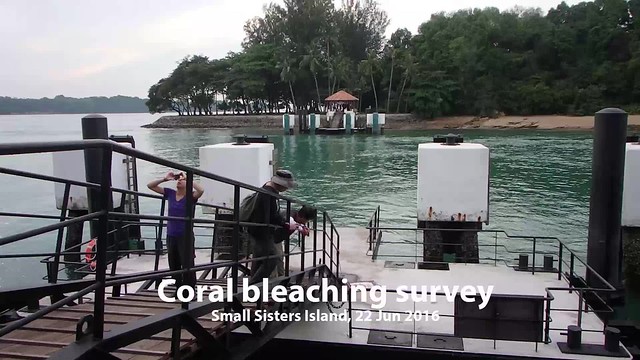The survey team asssess about 30% of the hard corals we saw were bleaching, 40% for leathery soft corals and 50% for sea anemones. But this reef does not have much corals on the intertidal to begin with.
Here's a short video of the corals found under the jetty. Not all the hard corals here are bleaching.
Mass coral bleaching in Singapore is not unexpected. From the NOAA's coral reef watch satellite monitoring,Singapore is in the yellow Watch zone. Where we should be prepared for mass coral bleaching.
What is coral bleaching?
Coral are colonies of tiny animals called polyps. Each polyp lives inside a little hard skeleton. The huge colony is made up of the skeletons of countless polyps. The polyps of all reef-building hard corals harbour microscopic, single-celled algae (called zooxanthellae). The polyp provides the zooxanthellae with shelter and minerals. The zooxanthellae carry out photosynthesis inside the polyp and share the food produced with the polyp. Corals generally have white colour skeletons, which is believed to assist in photosynthensis by reflecting light onto the zooxanthellae.
When there is massive loss of zooxanthellae in a hard coral colony, the polyps become colourless and the underlying white skeleton shows through. Thus patches of the colony appear pale, white or 'bleached'. The polyps are still alive and the hard coral is not dead (yet).
Without the food provided by the lost zooxanthellae, the polyps will be stressed and prone to diseases. Skeleton production and reproduction are also affected.
 |
| Patches of this bleaching coral has died, and the dead portion is taken over by scummy growths. |
 |
| This coral has greyish skeleton that looks melted. Disease? Eaten by a nudibranch? |
Factors believed to cause bleaching include: temperature fluctuations (too high or too low), excessive exposure to ultraviolet light, excessive sedimentation in the water, changes in salinity and disease. It is generally believed that bleaching is related to unusual prolonged temperature increases in the seawater. Hard corals harbouring zooxanthellae live close to the upper limit of temperature tolerance. Thus a temperature increase of even 1-2 degrees centigrade can redult in bleaching. It is believed that global warming will lead to massive bleaching.
Little Sister's Island doesn't have a lot of hard corals and soft corals to begin with. The rocky reef flat is dominated by Blue coral and sponges of various kinds. These looked alright today.
The many Blue corals on this shore seemed alright. I only saw one with a small patch of white skeleton. Blue corals are not blue and are not hard corals! Technically, they are grouped with soft corals.
Today, about 30% of the hard corals that I saw were bleaching. And bleached corals were found right next to corals that seemed alright. But is the rate of bleaching low because many of the bleaching corals have died?
I saw few small disk corals, only one Flowery disk coral was bleaching.
Most of the Merulinid corals (previously Family Faviidae) were alright, even those growing on the seawall.
Another selection of Merulinid corals seen today. Most were small to medium sized colonies.
Most of the Boulder pore corals were also alright, although a few were very green.
I saw a few Cauliflower corals growing on the pontoon pillar, they were bleaching. I only saw one small Crinkled sandpaper coral and it was very pale but not bleaching. I didn't see any other kinds of hard corals.
About 40% of the leathery soft corals were bleaching. I saw several small to medium-sized colonies and most were alright, even those growing on the seawall.
Only part of this leathery soft coral is bleaching.
Another leathery soft coral colony that appears to be dying, the tips taken over by fluffy algae.
The centre part of the this leathery soft coral colony appears to be dying, the tips taken over by fluffy algae.
Animals that contain symbiotic algae also bleach. These include sea anemones. Today about 50% of the sea anemones I saw were bleaching. I saw two Bubble tip anemones and both were bleaching, no anemonefishes in them. About 70% of the Frilly sea anemones were bleaching. I saw several Giant carpet anemones (no anemonefishes), Haddon's carpet anemones and one Wiggly reef star anemone, all were alright. Marcus saw one bleaching Giant carpet anemone on the high shore.
A few Button zoanthids were bleaching and some of the Sea mat zoanthids had white patches. I saw a few bleaching Fine feathery soft corals. But the few patches of Corallimorphs that I saw were alright.
The water in the reef flat was teeming with tiny fishes of all kinds. There were also crabs, shrimps and I saw one Reef octopus.
Unlike on our last survey here in Feb 2015, I didn't see any Five-spot anemone shrimps, but did see one Tiny carpet anemone.
The big lagoon is now well covered with Spoon seagrass, with tiny leaf blades. The seagrasses look well. There were many Common sea stars, some Moon snails and Fan clams and many Haddon's carpet anemones here. But I didn't see any cerianthids.
There was one small ring of Tape seagrass in the small lagoon. The leaf blades were rather short.
The two Sisters Islands are now designated as a Marine Park and managed by NParks. While visits are permitted on Big Sister's Islands, Little Sister's Island is closed to visits and set aside for research. Our visit today was done with permission from NParks.
Our last survey here was in Feb 2015. We don't often survey this small island. I hope it stays safe until we return. Tomorrow morning we will be checking up on mass coral bleaching at Big Sisters Island.
High res photos of mass coral bleaching in Singapore for free download on wildsingapore flickr
Posts by others on this trip
- Lim Yaohui on facebook.
- Marcus Ng on facebook.
- Richard Kuah on facebook.
- Lisa Lim on facebook.

























